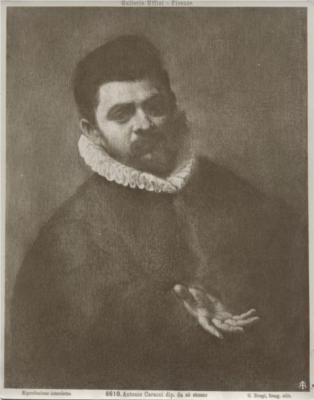Oil Painting » List of Painters » Agostino Carracci
AGOSTINO CARRACCI:
Agostino Carracci was a leading Italian painter, draughtsman, and printmaker of the Baroque period. He was born in Bologna in 1557 and was the oldest of three brothers who were all artists. His brother, Annibale, was a leading painter of the Baroque and his other brother, Ludovico, was a printmaker and engraver. Agostino was trained by the Carracci family workshop and was heavily influenced by the works of Correggio and Parmigianino.
Agostino Carracci's early works were mainly frescoes, which were then followed by small-scale cartoons and illustrations. He was especially known for his religious works, which were often more restrained and less emotive than the works of his contemporaries. He was also known for his landscapes, which he painted in a softer, more realistic style. He painted a series of landscapes for the Palazzo Magnani in Bologna.
In 1577, Agostino Carracci moved to Rome and established an academy of painting with his brother Annibale and cousin Ludovico. The academy was known for its practical approach to teaching and for its emphasis on the imitation of nature. Agostino was also heavily influenced by the works of Michelangelo and Raphael.
In 1584, Agostino Carracci left Rome and returned to Bologna, where he continued to work as a painter and engraver. He painted frescoes for the Palazzo Magnani and for the churches of Santa Maria dei Servi, San Domenico, and San Petronio. He also painted a series of altarpieces for the churches of San Michele in Bosco, Santo Stefano, and San Bartolommeo.
Agostino Carracci's later works were more naturalistic and more sensuous than his earlier works. He was heavily influenced by the works of Titian and his works often featured a vibrant palette and an abundance of detail. He also developed a softer style of painting, which was characterized by delicate shades of light and shadow.
Agostino Carracci was an important figure in the development of the Baroque style of painting. His works were influential in the development of the Bolognese school of painting, which was characterized by its naturalism and its use of light and shadow. He was also an important figure in the development of the Caravaggio style of painting, which was characterized by its dramatic lighting and its use of intense colors. His works were greatly admired by his contemporaries and his influence can still be seen in the paintings of many of the leading painters of the Baroque period.

Personal Details
| Name | Agostino Carracci |
| Place of birth | Bologna |
| Date of Birth | November 3, 1560 |
| Date of Death | March 22, 1602 |
| Nationality | Italian |
| Field | Painting,Printmaking |
| Popular Works | Head of a Faun in a Concave, The Communion of St. Jerome, The Ecstasy of St Catherine |
CAREER:
Carracci was the first of the three brothers to study painting, and his earliest works date from the 1570s. He initially studied under his uncle, the painter Annibale Carracci, who was then based in Rome. Agostino and Annibale worked together for several years, until Annibale's death in 1595.
Agostino's style was heavily influenced by his study of the works of Raphael, Michelangelo and the Venetian school. He was also an important figure in the development of the Baroque style, blending the Renaissance ideal of clarity and harmony with the Baroque's dynamic and expressive elements. Agostino's work was characterized by a heightened sense of movement and emotion, often expressed through dramatic gestures and poses.
Agostino's most famous works include his altarpieces for the churches of Santa Maria in Vallicella, Santa Maria della Pace, and Santa Maria della Misericordia in Rome. He also produced a series of frescoes depicting the life of the Virgin Mary in the church of Santa Maria in Vallicella. In addition to his religious works, Agostino also created a number of portraits, including his own self-portrait, as well as a portrait of Pope Clement VIII.
Agostino's work had a profound impact on the development of the Baroque style. He is credited with being one of the first artists to experiment with the use of color and light, which helped to create a more dynamic and expressive style. His work was also highly influential on the development of Italian painting in the 17th century.
Agostino Carracci's legacy lives on in the works of his descendants, who continued to carry on his style of painting. His influence can still be seen in the works of many of the great artists of the Baroque period, including Pietro da Cortona, Guido Reni and Giovanni Lanfranco. Agostino's work has also been an inspiration for modern painters, such as Lucian Freud and Francis Bacon.
WORKS OF AGOSTINO CARRACCI:



